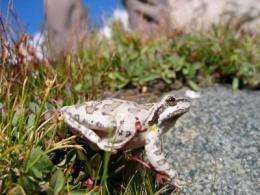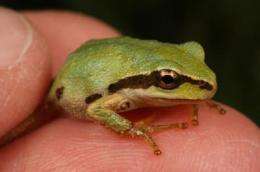Common North American frog identified as carrier of deadly amphibian disease

Known for its distinctive "ribbit" call, the noisy Pacific chorus frog is a potent carrier of a deadly amphibian disease, according to new research published today in the journal PLoS ONE. Just how this common North American frog survives chytridiomycosis may hold clues to protect more vulnerable species from the disease.
Chytrid has wiped out more than 200 frog species across the world and poses the greatest threat to vertebrate biodiversity of any known disease.
In California's Sierra Nevada Mountains, San Francisco State University biologist Vance Vredenburg has studied the impact of chytrid since 2003. His team's latest findings suggest the disease is widespread among Pacific chorus frogs but the species rarely shows symptoms, making it a highly effective carrier.
"We found that the vast majority of Pacific chorus frogs don't die or show symptoms even with surprisingly high levels of infection," said Natalie Reeder, who conducted the research for her master's thesis at SF State. "They are able to go about life as normal, moving over land and carrying the disease to new locations."
Pacific chorus frogs (Pseudoacris regilla) are one of the most common frogs on the west coast of North America and are found along the Pacific coast from Baja California to British Columbia. These small frogs range in color from bright green to gold or brown, and are common in urban yards and parks as well as remote habitats.
Their abundance and mobility make them dangerously effective at spreading the chytrid fungus. The frogs have sticky toe-pads that help them climb and can survive longer periods out of water compared to other species.
"The Pacific chorus frog is a perfect host for chytrid, allowing the disease to leap frog to the next pond over," said Vredenburg, assistant professor of biology at San Francisco State University. "The findings help explain the pattern and speed of the chytrid epidemic in the Sierras."
Chytridiomycosis is a deadly disease caused by an aquatic fungus called Batrachochytrium dendrobatidis (Bd). Because it is a water-borne fungus, scientists assumed it would spread downstream through rivers and lakes. But in the Sierra Nevada, the epidemic moved uphill.

"Our findings explain the steady march of chytrid up the mountain," Reeder said. "These frogs can climb mountains and go places that are pretty dry."
Surveys in Sixty Lakes Basin in the Sierra Nevada revealed that between 2003 and 2010, Pacific chorus frog populations remained stable in 26 lakes and ponds and even colonized one new lake. During the same time period, a chytrid epidemic swept through the basin, causing mass die-offs among other species, such as the mountain yellow-legged frog, which was reduced to 5 percent of its historic habitat range.
Pacific chorus frogs survived the outbreak but did not escape infection. Skin swabs collected from the species in Sixty Lakes Basin in 2009 confirmed that two-thirds of the animals tested were infected with the Bd fungus.
Similarly in lab studies, 35 out of 39 frogs collected from the San Francisco Bay Area tested positive for the fungus. After four months of monitoring in the lab, 38 out of the 39 showed no symptoms of chytridiomycosis. Typical symptoms include weight loss, excessive skin shedding and a frog's inability to right itself when turned on its back.
"Pacific chorus frogs are not completely immune to the disease but under the right circumstances they seem to be able to cope with high levels of infection," Vredenburg said. Lab tests revealed the species tend to carry greater loads of the fungus, making it more infectious compared to other documented carriers of chytrid, such as the African clawed frog and the American bullfrog.
The study also identified an important survival mechanism that could help Pacific chorus frogs survive infection. The typical pattern of infection with chytrid involves the fungus attacking frogs' skin, causing it to become up to 40 times thicker than usual -- a deadly change given that frogs use their skin to absorb water and vital salts, such sodium and potassium. But in highly infected Pacific chorus frogs, the researchers found a mosaic of infected, thicker skin adjacent to normal skin.
"It looks like this patchy infection allows the healthy skin to continue functioning normally," Vredenburg said.
It is still unknown what keeps the infection from covering a frog's entire skin, but Vredenburg's next step is to investigate whether beneficial skin bacteria plays a role. If that is the case, the findings could inform the development of treatments to help more endangered amphibian species survive this global fungal epidemic.
More information: dx.plos.org/10.1371/journal.pone.0033567
Provided by San Francisco State University




















